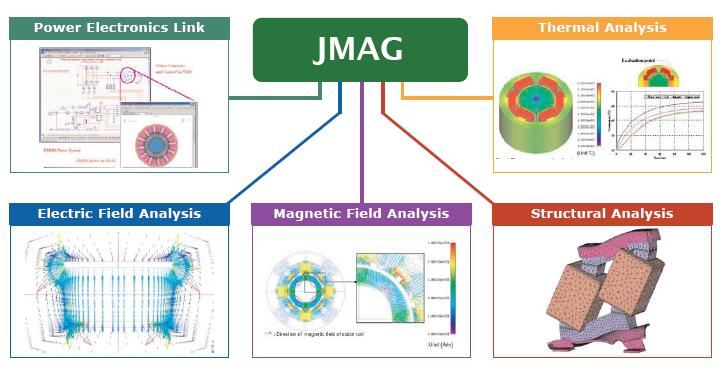JMAG on:
[Wikipedia]
[Google]
[Amazon]
 JMAG is a simulation software used to develop and design electric devices. JMAG was originally released in 1983 as a tool to support the design of devices such as motors, actuators, circuit components, and antennas.
JMAG incorporates simulation technology to accurately analyze a wide range of physical phenomena that include complicated geometry, various material properties, structure at the center of electromagnetic fields and thermal properties. JMAG has an interface capable of linking to third-party software and a portion of the JMAG analysis functions can also be executed from many of the major CAD and CAE systems.
JMAG is actively used to analyze designs at a system level that includes drive circuits by utilizing links to power electronic simulators. Engineers use JMAG for the development of drive motors for
JMAG is a simulation software used to develop and design electric devices. JMAG was originally released in 1983 as a tool to support the design of devices such as motors, actuators, circuit components, and antennas.
JMAG incorporates simulation technology to accurately analyze a wide range of physical phenomena that include complicated geometry, various material properties, structure at the center of electromagnetic fields and thermal properties. JMAG has an interface capable of linking to third-party software and a portion of the JMAG analysis functions can also be executed from many of the major CAD and CAE systems.
JMAG is actively used to analyze designs at a system level that includes drive circuits by utilizing links to power electronic simulators. Engineers use JMAG for the development of drive motors for
electric vehicles
An electric vehicle (EV) is a motor vehicle whose propulsion is powered fully or mostly by electricity. EVs encompass a wide range of transportation modes, including road vehicle, road and rail vehicles, electric boats and Submersible, submer ...
.
History
*1983 – JMAG Version 1 was released as a 3D static magnetic field analysis software. *1986 – JMAG DYN was released including 3D transient magnetic field analysis. *1994 – JMAG-Works was released integrating electromagnetic and thermal analysis. *1998 – JMAG-Studio was released as an integrated electromagnetic analysis software native to Windows. *2000 – Coupled analyses were implemented for control simulation. *2002 – JMAG-Designer was developed as an add-on for SolidWorks. *2004 – JMAG RT-Solutions was developed for model-based development of motor drive systems. *2007 – JMAG Motor Template 2 was developed for creating motor templates by specifying basic parameters such as the geometry and the windings. *2009 – JMAG Motor Bench and JMAG Transformer Design and Evaluation tools were developed to improve the manufacturing of devices. *2018 – JMAG-Express Online was released as a Free tool for designing and evaluating motor on a web browser.See also
*Computer-aided engineering
Computer-aided engineering (CAE) is the general usage of technology to aid in tasks related to engineering analysis. Any use of technology to solve or assist engineering issues falls under this umbrella.
Overview
Following alongside the con ...
*Finite element analysis
Finite element method (FEM) is a popular method for numerically solving differential equations arising in engineering and mathematical models, mathematical modeling. Typical problem areas of interest include the traditional fields of structural ...
*List of finite element software packages
This is a list of notable Computer software, software packages that implement the finite element method for solving partial differential equations.
Feature comparison
This table is contributed by a FEA-compareJMAG Application Catalog
JMAG-Express Online
JMAG-Express Online
External links
* {{CAE software Simulation software Finite element software Finite element software for Linux Sumitomo Mitsui Financial Group 1983 software